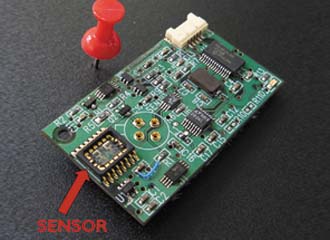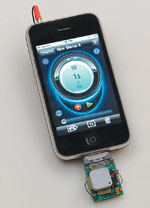A Sensor In Every Pocket
 |
The Homeland Security Advanced Research Projects Agency, in conjunction with several partners, is developing a chemical sensor that would fit into smart phones. The sensors would promote public safety and homeland security by crowd sourcing the sensors and would enhance private safety by alerting smart phone users to toxins in their areas. |
Scientists at the U.S. Department of Homeland Security are a phase closer to putting chemical detectors into the hands of everyone who wants them. Developers have finished demonstrating a miniaturized sensor that can fit into the now-omnipresent personal cell phone. Early testing shows promise for small, inexpensive technology, and over the next year or so project personnel plan to test its real-world application. The cell phone platform would enable crowd sourcing to reduce false positive readings, and it would support instant alerts that would send out timely notifications. The goal of developers is to improve public safety, enhance homeland security and ultimately save lives. In this next round of development, researchers with the program have to figure out how the network will support the technology and determine whether applications that seem strong in the laboratory will function in the field.
The Cell-All project expands detection efforts beyond the large, expensive, static sensors set up at specific locations and from the costly handheld sensors used by hazardous materials, or hazmat, teams after a substance has been found. Instead, the miniature sensor under development will integrate with smart phones to alert people to dangers and send notifications to emergency operations centers. “What we’re trying to do here is make chemical sensors part of the fabric of society,” explains Steve Dennis, technical director of the Homeland Security Advanced Research Projects Agency (HSARPA).
Phase 1 produced a first-generation laboratory prototype that demonstrated the feasibility of creating the small sensors and integrating them with smart phones. Developers wrapped up that portion of the project in January after proving the detector’s viability. In February, HSARPA officials met with representatives from smart phone manufacturers and first responders to determine the path forward. The private industry members offered advice on performance specifications such as size and power, and emergency response personnel provided input about what qualified as a meaningful detection. Dennis says his people got a good sense of what it will take to implement these sensors in cellular devices, but “it’s not something you do overnight,” he adds.
The project has advanced to Phase 2, in which developers will create more prototypes and gather evidence about performance. They also will study how the network can support Cell-All’s functions. Dennis says between 40 and 80 prototype phones will be created in the next 12 to 18 months. However, he explains, because no one has produced this type of technology before, all time frames are estimates. Phases 2 and 3 of the development will examine and categorize network effects as well as test the sensors in scenario-based events. Once developers have proved the sensor’s capabilities, they will work with network carrier partners to determine how the technology integrates with communications setups.
HSARPA already is working with NASA, Qualcomm and Rhevision Technology to create the new sensors. Each organization takes different scientific approaches to the problem. According to the Department of Homeland Security (DHS), Qualcomm engineers specialize in the necessary miniaturization and have the knowledge required to move a product to the marketplace. Scientists at the Center for Nanotechnology at NASA’s
As the project moves forward, organizations are looking at different ways to fund the effort. Dennis explains that HSARPA plans to use cooperative research and development agreements (CRADAs) that allow the government to have a mutual concern in work performed with industry dollars. The agency is pursuing four CRADAs now with cell phone manufacturers Qualcomm, LG, Apple and Samsung.
As developers work to create ubiquitous detection, they also must address the effect this level of data transmission would have on the network. “There’s a lot of information that is coming out of this project,” Dennis states. Researchers have to ensure systems do not become overwhelmed if a chemical incident were to occur in an area highly populated with the sensors. Dennis says that HSARPA has private industry partners working on that issue who are “very adept at making sure these things wouldn’t happen.”
Though Cell-All has obvious application to alert users to chemical attacks by terrorists, it also will notify people about any toxic chemicals in their vicinity. When the sensor notices a danger, it will vibrate or make a noise to warn the telephone owner. It also could send out text messages to people on a contact list so they could help the potential victim. The sensor is planned to detect common gases that people come in contact with regularly such as carbon monoxide, carbon dioxide, ammonia and chlorine. Cell-All also will help reduce false or inaccurate alarms from people who believe they sense the presence of a gas but who either are wrong or misidentify it.
 |
The NASA chemical sensing prototype is plugged into an iPhone 30-pin dock connector with the display-side up. Photo by Dominic Hart/NASA |
Dennis shares that detecting dangers early has a big impact on stopping the spread of an attack. Increasing the presence of sensors in communities is a forward-leaning and proactive approach to saving lives during a chemical emergency. “If we can do this, it will revolutionize how we think of chemical detection,” he says. The multisensor facet of the project enables the concept of crowd-sourcing detection inherent in the development of Cell-All. Achieving the usage options is still a distant goal, because developers continue to work on determining whether the sensors will work both in their miniaturized form and when placed in mobile devices.
Designers are developing two types of sensors: one will detect a specific danger, and the other is more generic and could detect a range of substances. The demonstration employed a sensor to find common industrial chemicals such as chlorine and ammonia, identified by a U.S. Chemical Safety Board report as ones that people come into contact with on a regular basis. The DHS also has a list of chemicals it identifies as priorities.
Developers first plan to tweak the sensor for chemicals they know they can read well, and then they will study more difficult ones. Determining which chemicals the sensor will be able to detect is one challenge facing researchers. The specific number and types of chemicals that the sensor will be designed to detect initially are as yet undetermined, according to Dennis, but some likely contenders are carbon monoxide and fire indicators. In addition to creating ways to detect substances, developers are examining environmental data to determine what chemicals could create false positives and how to prevent that from happening.
Because of privacy issues, the devices will send information to emergency personnel only if users opt into such a program. Even those participating will be protected because the alert will send only general information, such as location and substance, not any personal information about the smart phone owner.
The project has not yet focused on how emergency operations centers will be notified. However, Dennis notes that emergency operations centers already have reverse 911 capabilities, and they perform geometric sensing to determine where alerts originate. Cell-All likely would use something similar so that people on vacation in
Before that is worked out, developers are carefully spiraling prototypes and understanding the miniaturization levels that can be achieved in the manufacturing base to ensure the sensors can be created at high volumes for low costs. Evolution in manufacturing is helping them. For example, the developers may be able to use technology designed for large-screen TVs in which circuits are printed directly onto glass.
Price is one of the major issues that manufacturers will face as they move toward their goal of providing sensors for everyone. Anything that adds more than a dollar to the cost of the mobile devices will make it very difficult to succeed in the marketplace. “Let me tell you, the device manufacturers made that very, very clear,” Dennis says. He believes that the sensor will come in at the necessary price and last for the expected lifetime of a smart phone, which he pegs at 18 months.
Dennis explains that his idea for future marketing is to explain the personal safety value of smart phones that carry the sensors. He envisions them propagating in a manner similar to camera phones. At first, such devices were rare and expensive, but now a camera is standard on almost every personal communications device.
In the future, the sensors also could apply to detection outside of the chemical arena such as in agricultural pursuits. “There are a million and one uses for this,” Dennis says, adding that the potential for the sensors is beyond what can be fathomed now.
WEB RESOURCES
DHS Chemicals of Interest: www.dhs.gov/xlibrary/assets/chemsec_appendixa-chemicalofinterestlist.pdf
HSARPA: www.dhs.gov/xabout/structure/gc_1269620464785.shtm




Comments